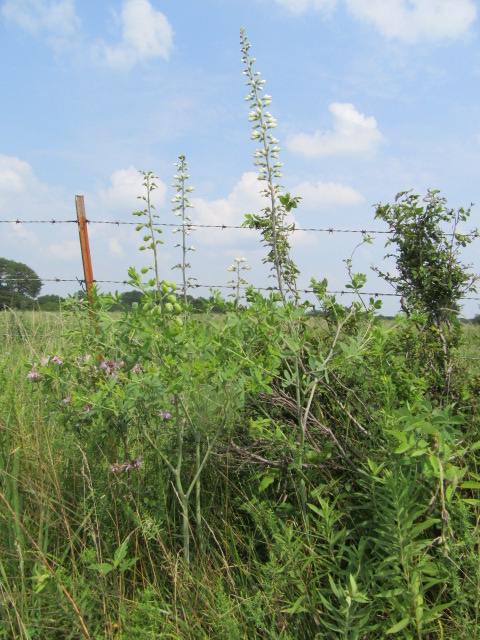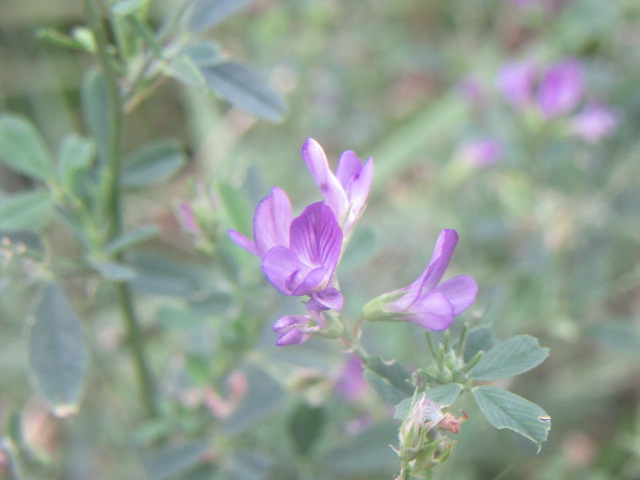
Baptisia australis cv. ? (Blue Wild Indigo, Blue False Indigo) on 5-23-21, #798-3.
Fabaceae Lindl.
fab-AY-see-ee
OR
fab-AY-see-eye
The plant family Fabaceae was named and described by John Lindley in An Introduction to the Natural System of Botany in 1836.
In the beginning of time, well, maybe not that far back, Antoine Laurent de Jussieu named the plant family Leguminosae. He described the name in Genera Plantarum in 1789. This family is now a synonym of the family Fabaceae.
As of 12-17-23 when this page was last updated, Plants of World Online lists 793 genera in the plant family Fabaceae. It is commonly known as the legume, pea, or bean family. The number of genera could change as updates are made on POWO.
There has been controversy when it came to deciding which family name to use, the use of subfamilies, etc. I am not going to go into detail about that but you can read about it by clicking the links below.
I have experience with several members of the plant family Fabaceae, mostly wildflowers. You can click on the plant names under the photos to go to their own pages if you like.
For more information about this family of plants, please click on the links below. The links take you directly to the information about the family.
PLANTS OF THE WORLD ONLINE
WIKIPEDIA
BRITANNICA
BETTER LEARNING THROUGH BOTANY

Amphicarpaea bracteata (American Hog Peanut) on 9-2-22, #908-1. Most of the leaves are from Japanese Honeysuckle.
While looking at the vines growing on the fence in the front pasture on September 2 in 2022, I noticed these weird flowers growing on the Japanese Honeysuckle. I thought that was odd so I looked closer and realized it was obviously a species I hadn’t identified before. I took photos and uploaded them to iNaturalist and found out the species is Amphicarpaea bracteata (American Hog Peanut). You never know what oddities you will find…
<<<<+>>>>

Baptisia lactea (Wild White Indigo, Western White Indigo, ETC.) on 7-22-21, #817-1.
I spotted my first Baptisia alba var. macrophylla (Wild White Indigo Indigo, ETC) on a backroad in 2018. Then, on July 20, 2021 I spotted another small colony on a different backroad. I didn’t have my camera, so I went back on the 22nd to take photos. The Missouri Plants website says the variety of Baptisia alba found in Missouri is assigned to Baptisia alba var. macrophylla…
Ummm… When I started updating the page for this species, I went to Plants of the World Online to se if the numbers were still the same. Well, to my surprise, POWO says Baptisia alba var. macrophylla is now a synonym of Baptisia leucophaea. Scientific names have changed A LOT over the last several years, but they slowed down somewhat, at least for this site. There are a lot of differences between the two so I sent an email to the editor to get his opinion… For now, I opt out of changing the name. I may rebel and not change it even after I get an explanation… How B. leucophaea became a synonym of B. alba var. macrophylla is weird in itself… As it turns out, one of the former synonyms of B. alba var. macrophylla, Baptisia lactea was resurrected which is this plant. In fact, almost all websites and observations for Baptisia alba and Baptisia alba var. macrophylla are now B. lactea. GEEZ WHAT A MESS!
<<<<+>>>>

Baptisia australis (Blue Wild Indigo) on 5-23-21, #798-1
So, I brought this Baptisia australis (Blue Wild Indigo, Blue False Indigo) home from a garden center in Clinton in April in 2017. There were quite a few expensive Baptisia ‘Lunar Eclipse’ blooming but I didn’t want to pay the price. They also had several pots that weren’t blooming for a lot less so I brought one home. The label said it was a ‘Lunar Eclipse’ but when it started flowering in 2018 something was dreadfully wrong. It was NOT a ‘Lunar Eclipse’. I suppose I can’t complain that much since the flowers are still very nice and the plant has definitely been hardy. Still, when you expect one thing and get another it can be frustrating. I told the owner of the garden center (where I also buy some of my garden seed from) and she didn’t have a whole lot to say. Labels get mixed up and when there are no flowers on the plants you just never know what you are bringing home. Anyway, I emailed the company that created ‘Lunar Eclipse’, sent photos, and we can’t put our finger on what cultivar this plant is… It is even possibly a hybrid with another species of Baptisia. Who knows…
<<<<+>>>>

Desmodium paniculatum ? on 10-12-21.
Sorry to say, but the best photo to describe the Desmodium paniculatum (Panicled-Leaf Ticktrefoil) is the seeds on my boots. I am somewhat confused whether the species here is Desmodium paniculatum or Desmodium perplexum. I am leaning toward D. paniculatum since it is somewhat variable, but it is perplexing.

Desmodium paniculatum {Panicled-Leaf Tick Trefoil) on 9-6-18, #503-19.
OK, I will also include a photo of the flowers… It could be that both species are present on the farm… Either way, they are a species you definitely love to hate. The Missouri Plants website has information on 7 species native to Missouri, and Plants of the World Online says there are 185 species in North America and other countries combined… GEEZ!
<<<<+>>>>

Genista spachiana (Sweet Broom) on 4-15-12, #86-34.
I brought this Genista spachiana (Sweet Broom) home from Lowe’s in 2012 while I was living in Mississippi. The label said it was a Genista racemosa, which is not an official species… I didn’t pay much attention to the label until I came home and put it in the planter. It said this plant could grow to 6′ tall x 6′ wide…
<<<<+>>>>

Kummerowia stipulacea (Korean Bushclover) on 9-6-18, #503-27.
Although I photographed the Kummerowia stipulacea (Korean Bushclover) growing in front of one of the ponds in the back pasture in 2018, I didn’t submit the photos to iNaturalist for an ID until 2023. There were four photos and I didn’t realize they were of two different species until an iN member mentioned it… If you look in the background, you will see the Kummerowia striata (Japanese Clover)…
<<<<+>>>>

Kummerowia striata (Japanese Clover) on 9-8-18, #504-33.
The other species was Kummerowia striata (Japanese Clover). Their flowers and leaves are somewhat different. Now I need more photos, preferably close-ups… It could be tricky because the leaves and flowers are very small. It’s funny how both species are growing together. Apparently, this is not uncommon. I have no page for either species.
<<<<+>>>>

Lathyrus latifolius (Sweet Peas) on 6-24-17, #349-50.
A LOT of Lathyrus latifolium (Broad-Leaved Sweet Pea, ETC…) is growing in an area north of the chicken house here on the farm. There are 30 (or so) species of Lathyrus native to the United States, but this one was introduced to American gardeners in the 1700’s and escaped. Now it can be found growing in the wild in almost every state… Common names include Broad-Leaved Sweet Pea, Everlasting Pea, Wild Sweet Pea, Perennial Pea, Perennial Peavine, Everlasting Vetchling, Sweet Pea, and likely others…
<<<<+>>>>

Lotus corniculatus (Bird’s Foot Trefoil) on 7-17-19, #603-9.
I photographed this Lotus corniculatus (Bird’s Foot Trefoil) on a friend’s farm in 2019. They are growing along the edges of highways and backroads, but 2019 was the first time I saw it in a pasture… It was also growing in the gravel there.
<<<<+>>>>

Medicago sativa (Alfalfa) on 8-2-19, #609-32.
Medicago sativa (Alfalfa) is widely used for hay and has escaped cultivation to be considered an introduced wildflower throughout the United States. I have only seen it once and this plant was growing along the road in front of the pasture. I don’t think this species is seen that often in the wild, at least not around here.
<<<<+>>>>

Melilotus albus (White Sweet Clover) on 8-2-19, #609-34.
I found a very small colony of Melilotus albus (White Sweet Clover) growing along the fence in the front pasture by the road on August 2 in 2019. By that time, the only thing left were a few flowers…
<<<<+>>>>

Melilotus officinalis (Yellow Sweet Clover) on 6-19-19, #592-27.
I found a small colony of Melilotus officinalis (Yellow Sweet Clover) while working on a friend’s farm in 2019. Although the species is found throughout Missouri, and all over the country, it was the first time I had ever seen any. Since 2019, I have seen a few along back roads and highways but I don’t always take my camera (and I don’t have a cell phone).
<<<<+>>>>

Mimosa quadrivalvis var. nuttallii (Cat’s Claw Briar) on 6-24-22, #895-3.
I found a small colony of Mimosa quadrivalis var. nuttallii (Cat’s Claw Briar) at the corner or a back road south of town. I hadn’t seen this species as a kid, so I was happy to find it. I remember as a kid touching their leaves and they would fold up. It’s a really neat plant with very interesting flowers and very thorny stems.
<<<<+>>>>

Senna marilandica (Maryland or Southern Wild Senna) on 9-24-23, #963-33.
The summer of 2023 was very hot and dry, probably the worst I have seen. By mid-summer, most of the wildflowers in the pasture and hayfield were dried up. Even so, I still managed to identify several new species before the drought and in September and October when we had a little rain. While walking along the fence on the south side of the south hayfield on 9-24-23, I ran across a plant I hadn’t seen before. I uploaded photos on iNaturalist and it turned out to be Senna marilandica (Maryland or Southern Wild Senna). I was too late for photos of their blowers, but…

Senna marilandica (Maryland or Southern Wild Senna) on 9-24-23, #963-34.
I did get photos of its seed pods… I have no page for this species yet…
<<<<+>>>>

Strophostyles helvola (Amberique/Fuzzy Trailing Bean) on 8-8-22, #903-15.
I first noticed this interesting bean growing in the fence row along the front pasture on August 2 in 2019. Most of the photos were blurry, but I managed to find a couple to load to iNaturalist for an ID. It turned out to be Strophostyles helvola (Amberique/Fuzzy Trailing Bean). In 2022, the vines had moved from their usual spot closer to the gate but still on the same fence. I found them earlier, so I took several good photos.
That’s all I have for the plant family Fabaceae for now. I’m sure there will be more in the future.